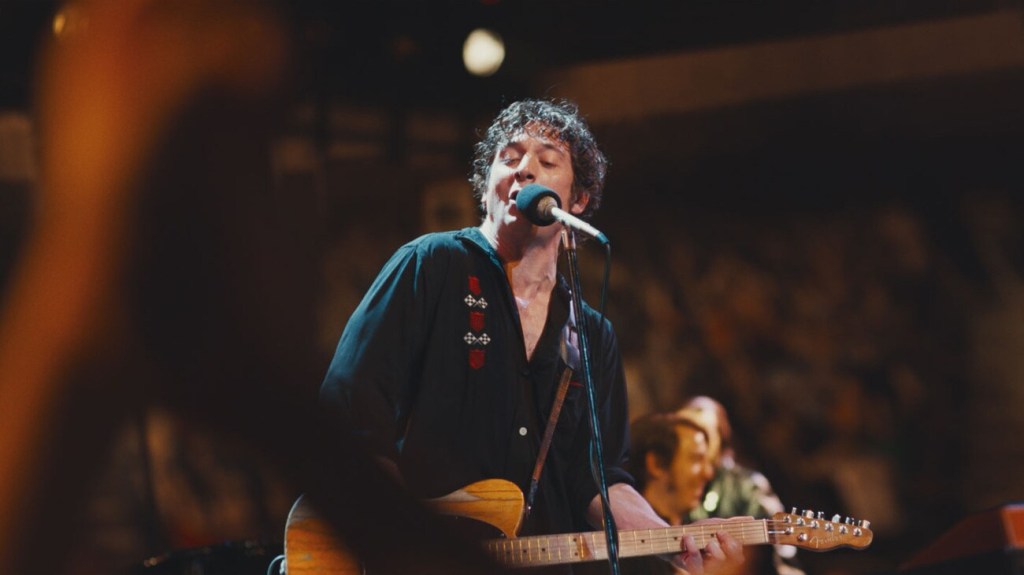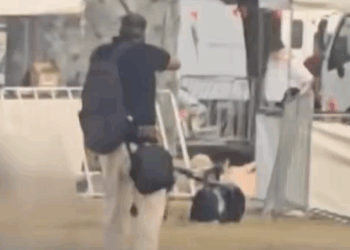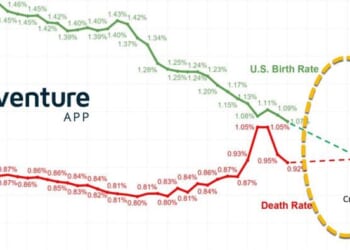
The first problem faced by any Bruce Springsteen biopic is, as someone recently put it to me, “Why wouldn’t I just pull up YouTube and watch two hours of the real Bruce?” Bruce is Bruce because of who he is on stage—the noise, the sad-eyed joy, the open-hearted aggression, the charisma and sweat, and whatever ensorcelling quality combines and transcends all these. Bruce tells stories in two- and three-minute increments, with emotional worlds bound by a few chords; confronted with all of this compressed energy, the staid conventions of the prestige biopic may seem unequal to the task.
Still, Shakespeare says that the world must be peopled, and judging by their steady rotation year after year through the Oscar campaigns, something similar applies to biopics of musical people. The inevitable disjunction between the charisma of a rock star and an actor’s portrayal is, in theory, a surmountable problem. But the second problem faced by Deliver Me From Nowhere is less surmountable: It’s a bad movie.
It’s a slog. A slog! I understand that we need to manage our expectations, that we’re not here for a live performance of “Born to Run,” but how do you turn Bruce Springsteen into a slog? A terminal self-seriousness helps. There are lingering close-ups of the tortured artist’s face; there are understated shots, ripe with meaning yet oblique, of the artist picking his guitar under yellow bedroom lights, walking down the street with his hands in his pockets, driving at night on dark Jersey highways. There is an absolute minimum of the E Street Band, because that would be fun, and we didn’t come here to have fun. There is a plot so high-minded, so focused on reverence for the art and delicate emotional excavations, that what little tension and action exist cash out to a study of the technical challenges of cutting masters from a four-track recorder, and to Bruce Springsteen being a jerk to a nice single mom.
Deliver Me From Nowhere depicts the making of Nebraska, Springsteen’s sixth studio album, produced after The River’s massive success but before Born in the U.S.A. rocketed him to global mega-stardom. It’s a stripped-down, folk rock album inspired, among other sources, by Flannery O’Connor, Terrence Malick’s Badlands (and the Starkweather murders the film was based on), and Springsteen’s own childhood ghosts.
The movie opens with a Springsteen ambivalent about his own success, with eager-eyed studio executives at his heels, baying for his next project. He begins tinkering in his New Jersey bedroom with a harmonica and a notebook. He meets Faye, a diner waitress living with her parents and raising a daughter, and kisses her on an Asbury Park carousel. He takes her daughter to the boardwalk. He sinks into a depression and stops returning Faye’s calls. He insists with manic intensity that his new album be produced exactly as he recorded it in his bedroom.
It is not easy to make a movie about the inner life of someone whose music is the most significant vessel for it. Ideally, the brooding sadness and anger in Nebraska, the sense of reading a letter from a condemned man, would bleed out imperceptibly and pervade the film; Springsteen’s soul sickness would become the context and the atmosphere. But actor Jeremy Allen White, despite what appear to be his best efforts, does not possess the soulful eyes or expressive features of his subject; he lacks both the lights and shadows. He plays Springsteen cagey, squirrelly, mumbling, and blank.
Instead, the filmmakers connect Nebraska with its maker’s struggles via a series of heavy-handed signposts. The audience is treated to a series of ludicrously obvious expository conversations between producer John Landau and his wife. We learn that there’s a real darkness in the album, and it probably comes from inside Bruce, as the wife sagely rubs lotion on her hands and nods. We learn that Bruce is feeling guilty and torn between the people he grew up with and the new realities of stardom. The wife sagely does something else and nods.
The ghosts of Bruce’s past appear in a series of black-and-white flashbacks: his father, drinking at the kitchen table; his mother, dancing with him to crooners on the radio. There is nothing wrong with these sensitive little vignettes, except for the attempt to make them exist in too neat a one-to-one relationship with whatever the adult Springsteen is going through. A scene in which Springsteen is working through a rough draft (or the musical equivalent) of the song that will become “Mansion on the Hill” is cut with a flashback of his father driving young Bruce to look at … a literal mansion on a hill.
Perhaps the choice to shoot the flashbacks in black and white was unfortunate; it contributes to a sense of overtidiness, of too clean a delineation between the Cause (the bad things that happened to you then) and the Effect (the bad things that are happening to you now), which is what people usually mean when they complain about the trauma plot. But why we break down, why we do the wrong thing at the critical moment, why we move to destroy ourselves at the exact moment of success—these are not tidy questions. They have an organic polymorphism, a watery abyssal depth, even when their answers seem most obvious. We go to therapy to boil our grief about our fathers down to a model simple enough to effect change in our lives. We go to art to find language to speak about grief as it is.
Realizing that you are not removed from your family curse, not merely an indirect victim or an observer, that the black dog that chased your father is chasing you, is rarely a sign-posted process. But it is usually a humbling process. Deliver Me From Nowhere is so reverent toward its subject, so eager to designate his breakdown as the capital-D Demons of a great artist, that it pulls its punches. When Springsteen is sitting across a table from Faye—the waitress whom he romances and, having thoroughly ingratiated himself into her little family, whose calls he stops returning with a predictability that in a different movie would be funny—she gives him the standard speech about being afraid of what they could be, being afraid above all to look inside himself and face his fears. But is this really what anyone ever wants from us when we are letting them down? To dig inside ourselves and come up with a final set of satisfying answers, or to present them with a complete and emotionally integrated persona? No. They want us to show up at the time and place we said we would.
The movie ends with one of the few genuinely unexpected and therefore genuinely moving scenes in the film. Springsteen’s father, now medicated for the unspecified mental illness (an illness, it seems clear, that he previously treated with alcohol) that dogged Springsteen’s childhood, groggily asks his son to sit on his lap. Bruce, drenched in sweat from a performance and entirely too old for such gestures, complies. His father tells Bruce that he knows he wasn’t always the best father, that appreciates his son’s financial support, that he’s proud of him. Bruce replies that it’s all right; he knows his father was fighting his own battles. There’s a dignity in the simplicity of what each side offers, and in Springsteen’s submission to the mawkish, embarrassing vulnerability of the conditions of the exchange. It’s a fine ending. It deserved a better movie.
















